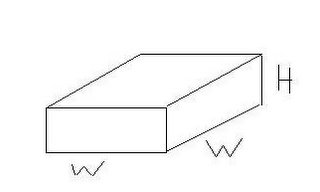4.7 Optimization Problems
We can use what we've learned about finding extreme values of functions to solve real-world applications that involve optimization--maximizing or minimizing something for the best results. There are eight main steps in solving these types of problems:
1) Read the question carefully and understand what the goal is (what information you are looking for).
2) Draw a diagram and label everything.
3) Determine the maximum/minimum equation.
4) Determine the constraints.
5) Use the constraint relationships to reduce the maximum/minimum equation to one variable.
6) Use the maximum/minimum equation to identify local maximums/minimums by taking the derivative and finding critical points.
7) Test the critical points and endpoints to determine the absolute maximum/minimum.
8) Answer the question asked.
Here is an example:
You construct mini, customized above-ground pools. One customer requests that you line their pool with red tile. You only have a limited amount of red tile and it is more expensive than regular tile. So, you want to minimize the amount of red tile you use. All your pools must be 400 cubic feet in volume. Your pools have square bases. Find the dimensions that minimize surface area.
So, following our 8 steps:
1) Our goal is: find the dimensions (the width and height) of the pool that yield the minimum surface area and a volume of 400 cubic feet.
2) Draw a diagram: the base is a square so its sides are both w. The height is h.
3) The max/min equation is:  , where w is the width and h is the height. Remember the base is a square, so the area of the base is
, where w is the width and h is the height. Remember the base is a square, so the area of the base is  . The total area of the four sides then is 4(wh). So you add
. The total area of the four sides then is 4(wh). So you add  and 4wh to get the surface area you need to cover with tile (the bottom of the pool and the four inner sides).
and 4wh to get the surface area you need to cover with tile (the bottom of the pool and the four inner sides).
4) Now for the constraints. Based on logical dimensions, you can say w is greater than 5 and less than 20 and that h is greater than 0 and less than 10. Also, the volume must equal 400 cubic feet. So, you can come up with a relationship for the volume:  .
.
5) Using the second constraint, you can reduce the minimum/maximum equation to one variable by solving the constraint for one variable. Choosing h would be easiest, so
 . Then, plug this into the min/max equation to get
. Then, plug this into the min/max equation to get
6) Now you take the derivative of f to find the maximums/minimums. You can also write f as . The derivative is
. The derivative is  . Set this equal to zero and solve to find the critical points:
. Set this equal to zero and solve to find the critical points:
w = 9.283
You can use the First Derivative Test to determine that 9.283 is a minimum. You can test using 1 and 10.
When w is less than 9.283, the derivative is negative and when w is more than 9.283 it is positive. S0, there is a minimum at x=9.283 because the derivative changes from negative to positive.
7) But is 9.283 an absolute minimum? When x is 9.283, f(x) is 258.53. Now test the endpoints of the domain of w--5 and 20. When w is 5, f(x) is 345 and when w is 20, f(x) is 480--both are greater than at w=9.283, so (9.238, 258.53) is the absolute minimum.
8) Our goal was to find the dimensions of the pool that yield the minimum surface area and a volume of 400 cubic feet. Luckily, we didn't lose sight of it, as is so easy to do. For the width, we got 9.283 ft. But we need the height too! We found earlier that
, so plug in 9.283 for w and you get 4.642 feet.
So our answer is:
9.283 ft by 9.283 ft by 4.642 ft.
Some cool links:
http://www.qcalculus.com/cal08.htm
http://tutorial.math.lamar.edu/AllBrowsers/2413/Optimization.asp
And here's a nice picture I took:
RYAN, you are up next.












1 Comments:
Dude Isaac this is an awesome blog. Thanks for the great optimization problem example. It really helped me get the part about making the equation contain only one type of variable before taking the derivative. Oh, and that's a good picture.
Post a Comment
<< Home